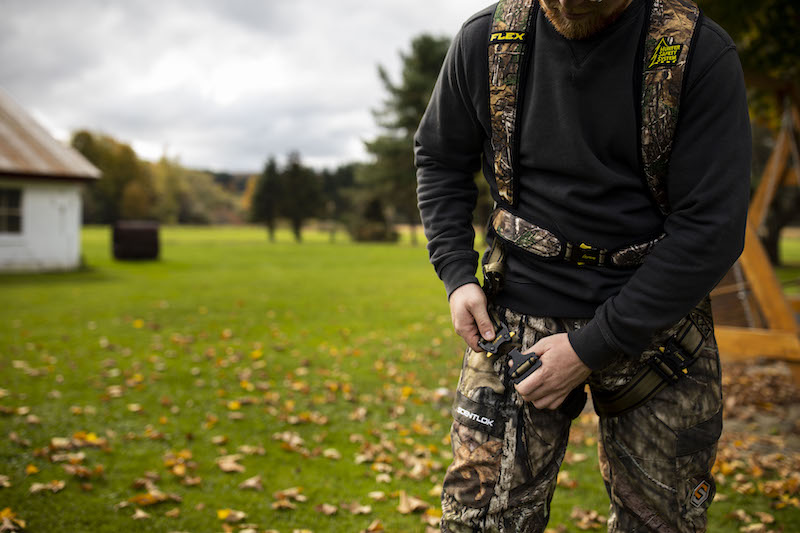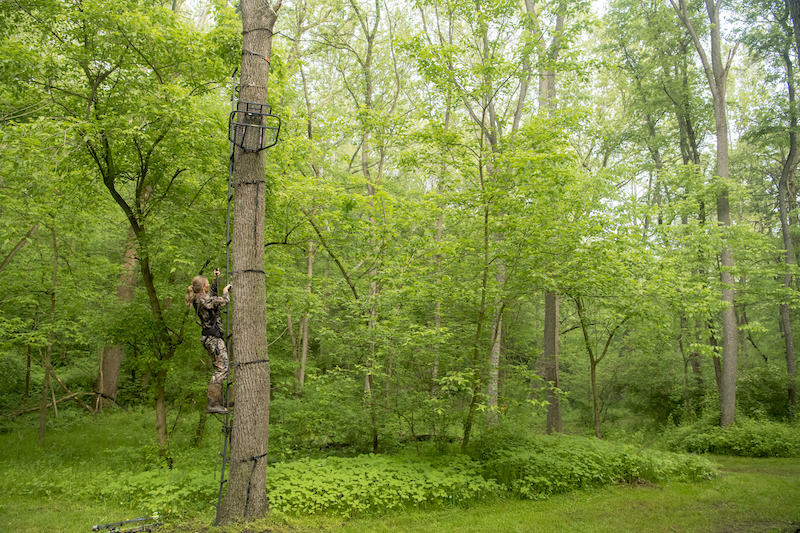Treestands get you off the ground to improve your view, shorten shooting distances, and help conceal you while bowhunting.
Getting 16 feet above deer is an advantage, but if you’re new to treestand hunting it’s normal to feel uneasy the first time you climb aboard. Don’t worry. That’s natural. We have some tips to make you feel more at home on these elevated platforms.

Make sure you are wearing your harness at all times. Photo Credit: ATA
A full-body treestand harness, and a lifeline or lineman’s belt, are must-haves every time your feet leave the ground. You can pick up these items at an archery shop, where staff will help fit your safety harness. When climbing, always maintain three points of contact, and slide your lifeline knot above your head as you go. If you use a lineman’s belt, keep it tight and above your waist as you climb. Learn more about treestand safety here.

Start by setting your stand just a few feet off the ground, then work your way up. Photo Credit: ATA
Do you remember your first few shots with your bow? They likely felt awkward, but eventually felt natural. Setting up and climbing into a treestand is no different. It just takes practice and repetition to get comfortable.
If you’re using a hang-on treestand, practice setting up your stand and climbing sticks or tree steps at ground level or slightly higher. Use all of your safety equipment, even though you’re not risking serious injury while practicing on or near the ground.
Practice similarly with a climbing treestand. Find a suitable tree, put on your safety gear, and practice going up and down its trunk until mastering the technique. One tricky aspect of climbing treestands is learning to climb quietly. You’ll learn through repetition to silently and safely get into position.
Practice runs are also excellent for checking your gear. Does your safety harness fit correctly? Do you hear squeaks or other noises as you shift your weight or move around on the stand? Have you worked out a system for carrying your treestand?

Practice shots from your stand and account for the angle. Photo Credit: ATA
Most archers practice on a flat range, but treestands force you to shoot at downward angles. The key to shooting downward is bending at the waist, which consistently aligns your upper body. An easy reminder is to hinge at the hips. If you must shoot at extreme downward angles, open your stance for more range of motion. You can practice on steep hills, an elevated deck, or your treestand itself.
You must also apply a little geometry when shooting from treestands. The distance from the treestand to the target is longer than the distance from the base of the tree to the target.
When selecting your sight pin, use the distance from the base of the tree to the target. You can automatically compensate for the treestand’s distance with an angle-compensating laser rangefinder. If your rangefinder lacks this feature, range the area before climbing into your treestand.
As you practice using and shooting from your treestand, you’ll gain the confidence needed to enjoy your hunts this fall.